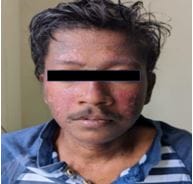A Tale of Two Male SLES (Systemic lupus erythematosus)
Pavithira A.1, Sucharitha S.2*
DOI: https://doi.org/10.17511/ijmrr.2022.i06.02
1 A. Pavithira, Senior Resident, Department of General Medicine, NRI Medical College and General Hospital, Chinnakakani, Mangalagiri, Mangalagiri, Andhra Pradesh.
2* S. Sucharitha, Post graduate, Department of General Medicine, NRI Medical College and General Hospital, Chinnakakani, Mangalagiri, Mangalagiri, Andhra Pradesh.
SLE is an autoimmune disease with multisystem manifestations. SLE is more common in females typically beginning in the childbearing years suggesting a role for both hormones and as yet uncharacterized sex-related factors in the disease pathogenesis. The prevalence of the disease being one male patient for every 8-15 patients, the disease manifestations in male patients are considered to be graver than in females. Here is a case reporting of two males who came with different presentations of SLE , the first patient presented with rash,fever,alopecia,and arthralgia of small joints , the second patient presented with fever, easy fatiguability ,generalised edema ,breathlessness on exertion .Both of them were evaluated and found to have strong positive for ANA and ds DNA and EULAR ACR criteria for SLE was applied and both were diagnosed as SLE .They were treated with steroids and other immunosuppressants .Clinical improvement was noticed in both patients.
Keywords: SLE, male, Anemia, Alopecia, ANA
| Corresponding Author | How to Cite this Article | To Browse |
|---|---|---|
| , Post graduate, Department of General Medicine, NRI Medical College and General Hospital, Chinnakakani, Mangalagiri, Mangalagiri, Andhra Pradesh, . Email: |
A. Pavithira, S. Sucharitha, A Tale of Two Male SLES (Systemic lupus erythematosus). Int J Med Res Rev. 2022;10(6):171-175. Available From https://ijmrr.medresearch.in/index.php/ijmrr/article/view/1406 |


 ©
© 